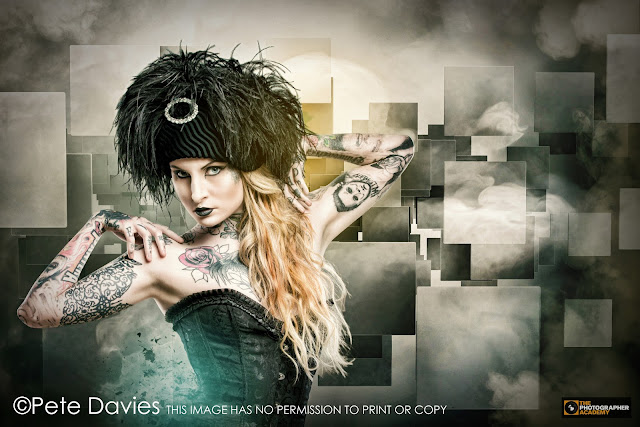Portrait Photography: Narrow & Broad Lighting
Narrow and broad lighting are probably the two terms that are the most confusing for portrait photographers, but they are two powerful techniques that you must learn and understand. They are both based on 45° lighting.
Narrow Lighting
In narrow lighting, as you might expect, only a relatively small area of the face is highlighted.
With the 45° lighting set-up in place, ask your model to turn or tilt his or her head toward the shoulder nearest the key light, so that it illuminates the area from the ear (if it is visible) to the tip of the nose on the side of the face furthest from the camera. Although more of the shadowed side of the face is visible, the highlighted side now occupies a relatively small area of the picture.
Because only a relatively small area is highlighted, narrow lighting instantly makes the subject look thinner. If the face is turned too far, however, the key light will start to light the shadow side of the face and the effect will be lost.
This technique should not be confused with split lighting.
Broad Lighting
In broad lighting, the head is turned slightly away from the key light. The highlighted area now appears wider than the shadowed side and, because the eye is instantly drawn to the highlighted flesh, the face seems wider and fatter. This is exaggerated in a low-key style of portrait, as the highlighted skin stands out even more against a dark background.
Broad lighting can be used to give power and strength to a portrait and is generally used in male portraiture to exaggerate the subject’s masculine qualities. Be careful not to turn the face too far, as this will make the ear dominate the portrait, even when it is in shadow.
Broad lighting should not be confused with flat lighting, but both techniques give the appearance of weight gain.
Tilting the Head
The shot on the left demonstrates the use of narrow lighting. In the shot on the right a shift in pose, with no adjustment to the lighting, accidentally produced a broad-lit image. As you can see, the narrow-lit image is far more appealing to the eye.
Tips:
Narrow lighting is great for women and for reducing overall body size.
Always shoot women from above bust height to exaggerate the eyes and make the neck look longer.
For a more dramatic image, turn off the fill light.
Now Try This...
Photograph several individuals using both narrow and broad lighting techniques. Then show different people the pairs of images and ask which ones they find most attractive. You will find that most people prefer the narrow-lit images.
by Mark Cleghorn
You can find lighting tecnique films on PhotoTraining4U by clicking HERE
Narrow Lighting
In narrow lighting, as you might expect, only a relatively small area of the face is highlighted.
With the 45° lighting set-up in place, ask your model to turn or tilt his or her head toward the shoulder nearest the key light, so that it illuminates the area from the ear (if it is visible) to the tip of the nose on the side of the face furthest from the camera. Although more of the shadowed side of the face is visible, the highlighted side now occupies a relatively small area of the picture.
Because only a relatively small area is highlighted, narrow lighting instantly makes the subject look thinner. If the face is turned too far, however, the key light will start to light the shadow side of the face and the effect will be lost.
This technique should not be confused with split lighting.
 |
| Narrow lighting - Narrow lighting puts most of the face in shadow but brings attention to the five planes of the face—the forehead, nose, chin, and the two cheeks. |
Broad Lighting
In broad lighting, the head is turned slightly away from the key light. The highlighted area now appears wider than the shadowed side and, because the eye is instantly drawn to the highlighted flesh, the face seems wider and fatter. This is exaggerated in a low-key style of portrait, as the highlighted skin stands out even more against a dark background.
Broad lighting can be used to give power and strength to a portrait and is generally used in male portraiture to exaggerate the subject’s masculine qualities. Be careful not to turn the face too far, as this will make the ear dominate the portrait, even when it is in shadow.
Broad lighting should not be confused with flat lighting, but both techniques give the appearance of weight gain.
 |
| Broad lighting - Broad lighting highlights and accentuates the broadest side of the face visible to camera. |
The shot on the left demonstrates the use of narrow lighting. In the shot on the right a shift in pose, with no adjustment to the lighting, accidentally produced a broad-lit image. As you can see, the narrow-lit image is far more appealing to the eye.
 |
| Accidental broad lighting |
 |
| Classic 45° Lighting |
Tips:
Narrow lighting is great for women and for reducing overall body size.
Always shoot women from above bust height to exaggerate the eyes and make the neck look longer.
For a more dramatic image, turn off the fill light.
Now Try This...
Photograph several individuals using both narrow and broad lighting techniques. Then show different people the pairs of images and ask which ones they find most attractive. You will find that most people prefer the narrow-lit images.
by Mark Cleghorn
You can find lighting tecnique films on PhotoTraining4U by clicking HERE



